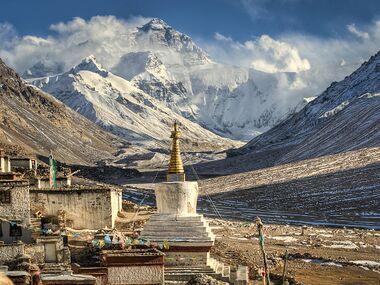Tibet
(Region) | |
|---|---|
 | |
Tibet is a region in East Asia. It is the traditional homeland of the Tibetan people as well as some other ethnic groups. Tibet is the highest region on Earth, with an average elevation of 4,380 m (14,000 ft).
The economy of Tibet is dominated by subsistence agriculture; tourism has become a growing industry in recent decades. The dominant religion in Tibet is Tibetan Buddhism and Bön.
Recent history
Following the Xinhai Revolution against the Qing dynasty in 1912, Qing soldiers were disarmed and escorted out of Tibet Area. The region subsequently declared its independence in 1913 without recognition by the subsequent Chinese Republican government. Later, Lhasa took control of the western part of Xikang, China. The region maintained its autonomy until 1951 when, following the Battle of Chamdo, Tibet was occupied and incorporated into the People's Republic of China, and the previous Tibetan government was abolished in 1959 after a failed uprising. Today, China governs western and central Tibet as the Tibet Autonomous Region while the eastern areas are now mostly ethnic autonomous prefectures within Sichuan, Qinghai and other neighbouring provinces. There are tensions regarding Tibet's political status and dissident groups that are active in exile. Tibetan activists in Tibet have reportedly been arrested or tortured.
CIA influence
Memorandum for the Special Group - Washington, January 9, 1964:[1]
Summary—The CIA Tibetan Activity consists of political action, propaganda, and paramilitary activity. The purpose of the program at this stage is to keep the political concept of an autonomous Tibet alive within Tibet and among foreign nations, principally India, and to build a capability for resistance against possible political developments inside Communist China.
Previous operations had gone to support isolated Tibetan resistance groups within Tibet and to the creation of a paramilitary force on the Nepal/Tibet border of approximately 2,000 men, 800 of whom were armed by [less than 1 line of source text not declassified] airdrop in January 1961.
In 1963, as a result of the [2 lines of source text not declassified] and as a result of the cited Special Group meeting, the Agency began a more broadly based political program with the exiled Tibetans. This included bringing 133 Tibetans to the United States for training in political, propaganda and paramilitary techniques; continuing the support subsidy to the Dalai Lama’s entourage at Dharmsala, India;
One of the most serious problems facing the Tibetans is a lack of trained officials equipped with linguistic and administrative abilities. The Agency is undertaking the education of some 20 selected Tibetan junior officers to meet this need. A United States advisory committee composed of prominent United States citizens has been established to sponsor the education of these Tibetans. Cornell University has tentatively agreed to provide facilities for their education.
The Agency is supporting the establishment of Tibet Houses in [less than 1 line of source text not declassified] Geneva, and New York City. The Tibet Houses are intended to serve as unofficial representation for the Dalai Lama to maintain the concept of a separate Tibetan political identity. The Tibet House in New York City will work closely with Tibetan supporters in the United Nations, particularly the Malayan, Irish, and Thai delegations.